VUMC to study COVID-19 and diabetes with VBDCC support
We are excited about the launch of the COVID-19 and Diabetes Assessment [CODA] Study, with principal investigators Russell Rothman, Alvin Powers, Jonathan Schildcrout, and Jason Block. The VBDCC will be instrumental in providing data coordination for this study. For more about the $28 million award from the National Institute of Diabetes and Digestive and Kidney Diseases, see the August 2 VUMC Reporter feature.
Vanderbilt Biostatistics at JSM 2023
The 2023 Joint Statistical Meetings, which convene in Toronto this Saturday, August 5, are expected to bring together more than five thousand attendees from 52 countries, with the theme of "One Community: Informing Decisions and Driving Discovery." We are proud of the department members and alumni who will be sharing their work, networking with current and future collaborators, contributing to section and conference planning meetings, and participating in other research and professional service activities. This year's conference program includes the following:
Saturday, August 5–Sunday, August 6
Regression modeling strategies: two-day course taught by professor Frank Harrell.
Monday, August 7
The ubiquitous Other in biomedical research: Alternatives to simply pooling racial groups with small sample sizes: topic-contributed session with research assistant professor Lauren Samuels as a panelist. 8:30 a.m.
A two-stage least squares-based approach for assessing the role of engagement in text interventions: contributed speed presentation by PhD student Jamie Joseph. Co-authored by assistant professor Andrew Spieker. 8:30 a.m.
Robust Effect Size Index analysis using RESI R package: contributed speed presentation by PhD student Megan Jones. Co-authored by PhD student Kaidi Kang and assistant professor Simon Vandekar. 8:30 a.m.
Design and analysis strategies with "secondary" use data: topic-contributed paper presented by assistant professor Ran Tao. 8:55 a.m.
Longitudinal analysis of HIV antiretroviral therapy effects on weight gain: topic-contributed paper presented by assistant professor Andrew Spieker. Co-authored by biostatistician Tan Ding, biostatistician Caroline Birdrow, and professor Bryan Shepherd. 9:35 a.m.
Total, between- and within-cluster Spearman's rank correlations for clustered data: contributed paper presented by PhD student Shengxin Tu. Co-authored by Chun Li (University of Southern California) and professor Bryan Shepherd. 10:05 a.m.
Rosenbaum & Rubin’s Propensity Score: Impact, introspection and discussion 40 years later: invited session with alumna Lucy D'Agostino McGowan as a panelist. 10:30 a.m.
Application of closed-form gamma mixture model in mxIF cell gating: contributed paper presented by PhD student Jiangmei (Ruby) Xiong. Co-authored by Eliot McKinley (GSK), research associate professor of surgery Joseph Roland, research professor of medicine Martha Shrubsole, professor of cell and developmental biology and surgery Ken Lau, and assistant professor of biostatistics Simon Vandekar. 11:05 a.m.
Improving reproducibility in neuroimaging studies: contributed papers session chaired by assistant professor Simon Vandekar. 2:00 p.m.
Study features impacting replicability of brain-wide association studies: contributed paper presented by PhD student Kaidi Kang. Co-authored by Jakob Seidlitz (Penn), Richard Bethlehem (Cambridge), Aaron Alexander-Block (Penn), and Simon Vandekar. 3:05 p.m.
At the Teaching Statistics in Health Sciences mixer, alumna Lucy D'Agostino McGowan will receive their Young Investigator Award.
Tuesday, August 8
Overcoming microbial and experimental design compositionality to test model-free variable importance: contributed paper co-authored by assistant professor Siyuan Ma. 9:50 a.m.
Optimal multi-wave validation of secondary use data with outcome and exposure misclassification: David P. Byar Early Career Award presentation by alumna Sarah Lotspeich. Co-authored by Pamela Shaw (Kaiser Permanente), assistant professors Gustavo Amorim and Ran Tao, and professor Bryan Shepherd. 9:55 a.m.
Submodel approximation for risk prediction of a new patient with missing risk factors: contributed paper presented by PhD student Tianyi Sun. Co-authored by assistant professor of biomedical informatics Allison McCoy, associate professor of emergency medicine Alan Storrow, and associate professor of biostatistics Dandan Liu. 10:35 a.m.
Design and analysis of a multi-wave two-phase study that addresses data errors in a large observational HIV network: topic-contributed paper presented by professor Bryan Shepherd. 10:55 a.m.
Synergizing emerging methods for high-dimensional genomics and imaging data: topic-contributed paper session organized by assistant professor Jinyuan Liu and chaired by PhD student Kaidi Kang. 2:00 p.m.
A new paradigm for high-dimensional data: Distance-Based Semiparametric Ensembled (DBSE) framework for various diversity measures of microbiome composition: topic-contributed paper presented by assistant professor Jinyuan Liu. 2:05 p.m.
Probability-scale residuals for mixed-censored data: contributed paper co-authored by professor Bryan Shepherd. 2:35 p.m.
Wednesday, August 9
Statistical innovation in emerging fields of clinical research: Diversity, Equity and Inclusion (DEI); Learning Health System (LHS); Dissemination and Implementation Science (D&I): invited paper session organized by associate professor Dandan Liu and chaired by professor Qingxia (Cindy) Chen. 8:30 a.m.
Statistical methods to address challenges in implementing a EHR-based prediction model in emergency departments: invited paper presented by Dandan Liu. 9:50 a.m.
Thursday, August 10
Electronic Health Record capture and research use in the All of Us Research Program: invited paper presented by professor Qingxia (Cindy) Chen. Co-authored by Andrea Ramirez (NIH). 8:55 a.m.
For a guide to JSM presentation types, see their sessions guidelines. ...And, if you're a Vanderbilt trainee, staff, or faculty member, consider preparing a submission for JSM 2024, in Portland, Oregon. Proposals for invited talks are due September 7, short courses by September 30, topic-contributed proposals by December 7, computer tech workshops by January 15, and contributed papers by February 1. The theme for 2024 is "Statistics and Data Science: Informing Policy and Countering Misinformation." Also, JSM 2025 will be in Nashville, from August 2 through 7, as will the Institute of Mathematical Statistics' New Researchers Conference.
VN-BioStat Program concludes its first year
The Vanderbilt-Nigeria Biostatistics Training Program (VN-BioStat) has concluded its first year. The program, a collaboration between the Department of Biostatistics, the Vanderbilt Institute for Global Health, and Aminu Kano Teaching Hospital (AKTH) in Nigeria, aims to create a cohort of highly skilled Nigerian biostatisticians able to lead and supervise biostatistics activities for HIV research studies in West Africa. Professor Bryan Shepherd is one of the program's principal investigators.
The program’s inaugural fellows were Abdurrahman Abdulhamid (PhD student, mathematics) and Yusuf Ibrahim Ibrahim (PhD student, statistics) from Bayero University Kano in Nigeria. Ibrahim has been working with professor Robert Greevy to study various randomization strategies for a proposed clinical trial in Nigeria. He is also doing a large epidemiology study looking at cytopenia among people with HIV in West Africa. Abdurrahman is looking at the interaction between sickle cell disease and renal disease among people with HIV using a cross-sectional dataset from northern Nigeria. They will continue this work when they return to Nigeria this month while they complete their PhDs at their home institution.
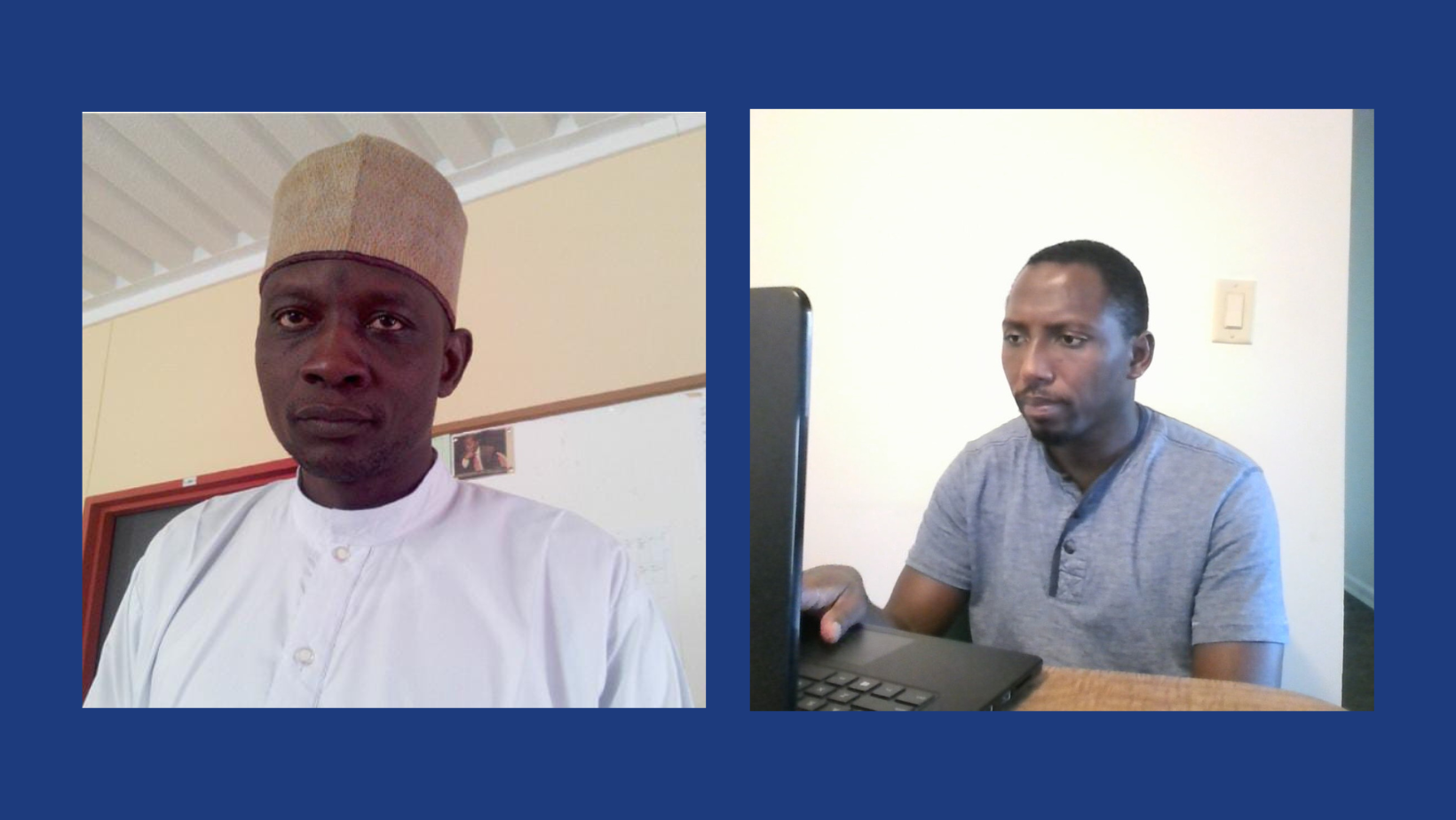
Left: Abdurrahman Abdulhamid; right: Yusuf Ibrahim Ibrahim
Below, Abdurrahman and Ibrahim share some of their experiences, insights, and advice for future fellows.
Abdurrahman Abdulhamid
Why did you want to join the program?
Assigned and provide analysis support to HIV-related research projects using AKTH data.
What did you like most about the program?
The unique responsibilities and project work associated with this program will absolutely help in developing the skills and experience required to work in a real job.
Did you learn anything that surprised you?
The whole idea of clinical trials, which is in every course in the six courses and weekly seminars, surprised me. Also, the professors are versed in excellent teaching methods.
What will you miss most about the program?
Resources that ease the study, and the prompt assistance from all the members of the Department of Biostatistics.
Do you have any advice for future fellows?
Try to harness the crude knowledge of the great scholars, and have helpful friends among the students.
What are you doing next?
To meet the target of the program by supporting projects at AKTH, and to continue and complete the project I started here and my PhD at Bayero University Kano.
Yusuf Ibrahim Ibrahim
Why did you want to join the program?
I applied this program because, in our country Nigeria, there is relatively a shortage of biostatisticians for the demand of biomedical research, resulting in generally overworked biostatisticians who work on multiple projects at the same time. This program will surely enable me to fill this gap.
What did you like most about the program?
It is great to study biostatistics in one of the focal points of biomedical research in the world. There are many brilliant and dedicated faculty here doing exciting research across a wide variety of critical areas. I admire all the staff of VUMC who are always ready to give you support whenever you need. I do like Nashville as a city. It’s a great place to live, as I am from tropics, however, I like the winter in Nashville. It’s nice seeing the snow for the first time. I will really miss the unique culture and hospitality of the people of Nashville.
Did you learn anything that surprised you?
Absolutely! I have had many wonderful experiences. For instance, before I came here, I looked at the R-software as a very complex and difficult thing to master. However, I was surprised by the ease I am now able to navigate many of its awesome features, courtesy of the fantastic teachers I have had here at Vanderbilt. I have been amazed by how they are able to make the seemingly difficult tasks so easy to master.
What will you miss most about the program?
I will really miss the weekly seminar in the Department of Biostatistics where dedicated academics present interesting research in a wide range of topics and ideas. I will also miss the staff and students of the Biostatistics Department and the Institute for Global Health who supported me intellectually, morally, and socially. Moreover, I will miss playing soccer with Bryan, Dale and others. The time we spent together will forever remain in my memory. Furthermore, I will forever be grateful for the warm hospitality of the people of Nashville.
Do you have any advice for future fellows?
Learning at an advanced level in a new culture/environment could be quite challenging and Vanderbilt, despite its excellence and prestige among the world’s universities, is no exception. I would like to advise the future fellows to prepare well in advance and work hard when they arrive. I have come to realize that the harder I work, the more I like and find ease in what I do. Moreover, they should always be open to meeting and learning from other people.
What are you doing next?
In six months, I just have a modes plan of finishing my PhD in Nigeria, after that, I will continue doing research in Statistics, especially “Causal Inference.” In two years, I wish to come back to one of the academic institutions in the United State as postdoctorate student. In five years, I have more of visionary plan – professionally, I would like to lead my own research group in Nigeria.
Biostatistics faculty in Taipei, Sint-Michielsgestel, and Ann Arbor
On June 9, department chair Yu Shyr (third from left) delivered "Future of Investigational Medicine and Smart Data—What We Learned from ChatGPT" as a keynote during the 2023 Health+ Conference hosted by Taiwan's Bureau of Foreign Trade. (Photo via Taiwan's Ministry of Economic Affairs.)
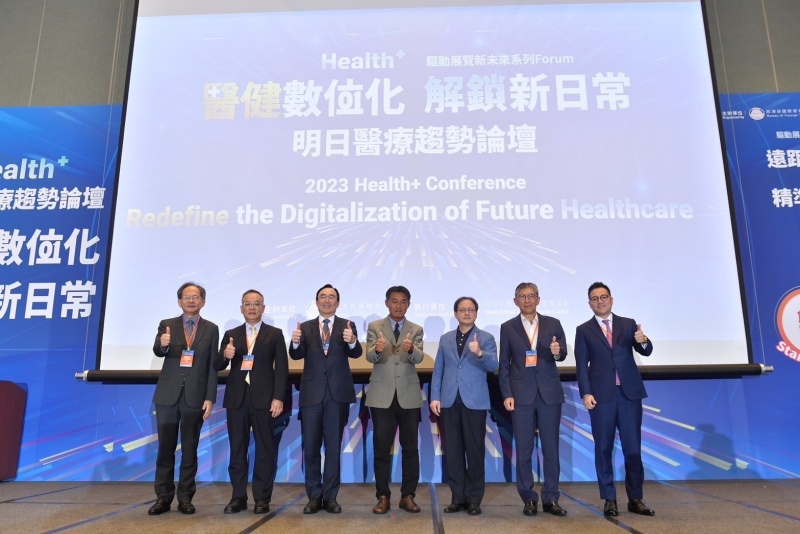
From June 17 through June 23, Shyr is serving as invited faculty in the 2023 EORTC-ESMO-AACR Workshop on Methods in Clinical Cancer Research (MCCR) in the Netherlands. Shyr has been involved with MCCR workshops since 2004 and will be speaking on "Novel Study Design and Analysis for Integrating Multi-omics Technologies for Early Detection of Cancer" at the 2023 ESMO Asia Congress this December in Singapore.
Assistant professors Jinyuan Liu and Panpan Zhang were invited speakers at the 2023 ICSA Applied Statistics Symposium, which was in Ann Arbor last week. Zhang organized and chaired "Statistical and Machine Learning Methods with Applications to Neurodegenerative Diseases" on June 13, and presented "A Covariate-Dependent Multi-Layer Network Model for Classification Analysis in Neuroimaging" on June 14. Liu presented "Edge: Ensembled Distance-Based Generalized Semiparametric Estimation for Between-Subject Attributes in Longitudinal Microbiome Data" on June 13.
This week both Liu and Zhang are at WNAR in Alaska as invited session organizers and speakers. See the conference website for more about their presentations, and our Upcoming Presentations page for more meetings and workshops where they and other colleagues will be representing Vanderbilt Biostatistics.
Biostatistics faculty and students at NESS and CFAR
This past week, presentations by our faculty and students included the following:
June 3–6, 2023 - New England Statistics Symposium (NESS), Boston
- Panpan Zhang, "Recent Advances in Neuroimaging Data Integration and Analysis" - invited session organizer (session chaired by Siyuan Ma)
- Kaidi Kang, "Double Anchoring Events Based Sigmoidal Mixed Model for Alzheimer’s Disease Progression Modeling" - student paper presenter (paper co-authored by Panpan Zhang and Dandan Liu)
June 5–6, 2023 - CFAR Symposium on Statistics and Data Science in HIV, Providence
- Bryan Shepherd, "The Vanderbilt-Nigeria Biostatistics Training Program" - invited speaker
On Tuesday, Kaidi Kang was named a NESS Student Research Award winner. He notes that the work started as as a course project with Dr. Liu. He will also be presenting work later this summer on effect sizes in brain-wide association studies (BWAS) at the Joint Statistical Meetings (#JSM2023) and the Organization for Human Brain Mapping's annual meeting (#OHBM2023), which was conducted in collaboration with professor Jonathan Schildcrout, assistant professor Ran Tao, PhD student Jiangmei Ruby Xiong, MS student Megan Taylor Jones, and assistant professor Simon Vandekar.
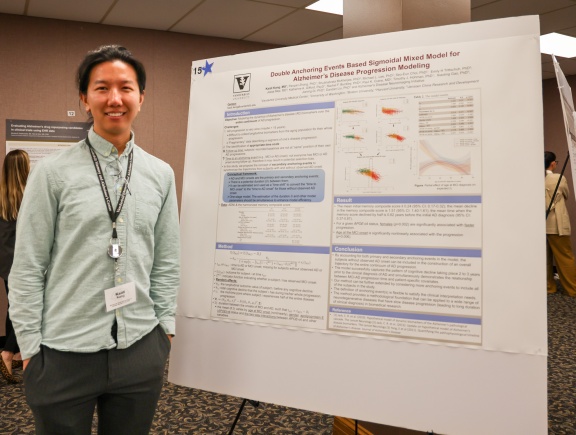
Chris Slaughter wins 2023 Vanderbilt Epidemiology Teaching Award
Associate professor Chris Slaughter has received the 2023 Vanderbilt Epidemiology Teaching Award. The student-nominated award honors a faculty member for their exceptional effort in training the next generation of epidemiologists in the PhD program.
Students who nominated Chris said that he “really tied all of the concepts we learned in our previous classes together to make them easier to understand,” and that he is “very patient and takes the time to explain concepts and ensure that they are understood.”
Chris received his PhD in biostatistics from the University of North Carolina at Chapel Hill. Since joining the Vanderbilt School of Medicine as an assistant professor in 2007, he has taught Clinical Pharmacology Biostatistics, Statistics for Biomedical Research, Modern Regression Analysis (for which he was a founding instructor), and Design and Analysis of Time to Event Data. He has co-authored almost 200 peer reviewed papers.
Some of Chris’s current research projects include a structure based design of trimer interface epitope focused universal influenza vaccines and therapeutic human monoclonal antibody treatments for filoviruses.
He is also part of the department’s upcoming Coursera program, which will debut within the next year. The program will include a series of courses on applied statistics in biomedical science. Chris is teaching Data Science Workflow for Clinical Trial Data, which will provide students with hands-on experience for successfully working with data collected during a randomized clinical trial.
Other courses in the program will be led by professor Tatsuki Koyama, assistant professor Andrew Spieker, and department chair Yu Shyr.
Congratulations, Chris, and thank you for all your hard work!

Learn about our 2023 summer interns
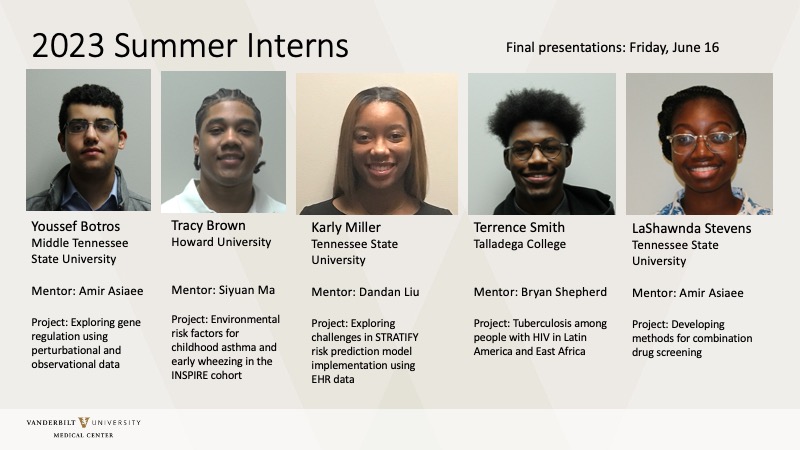
We have reached the midway point of this year's Internship Program for Underrepresented Undergraduates and are very much looking forward to the posters these emerging researchers will present at the close of their studies with us. See our Equity, Diversity, and Inclusion page for more about our efforts to promote accessibility and representation in our field, and our Graduate Program section for more about our MS and PhD tracks.
For a screen reader–compatible version of the above image, see the directory page for the 2023 cohort, which also acknowledges faculty and staff contributions towards making this year's program a success.
Vanderbilt Biostatistics at SMI 2023
The 2023 Statistical Methods in Imaging Conference took place this week in Minneapolis. Investigators and students from around the country gathered to discuss and share their work in the field of imaging science. We are proud of our department members who presented at the conference. They include the following:
Monday, May 22
PhD student Jiangmei “Ruby” Xiong presented a poster for “Application of Closed-Form Gamma Mixture Model in mxIF Cell Gating.” Assistant professor Simon Vandekar co-authored the poster.
Tuesday, May 23
Simon Vandekar was an organizer for the invited session “New Statistical Methods to Improve the Spatial-Omics Analysis Pipeline.”
Simon was also a session organizer for “Collaborative Case Study: Statistical Methods and Findings from Large Consortia Studies.” PhD student Kaidi Kang was an invited speaker in the session and presented “Study Features Impacting Replicability of Brain-wide Association Studies.”
Assistant professor Panpan Zhang was an invited speaker in the session “Recent Advances in Neuroimaging Statistics for Investigating Human Brain Function.” He presented “A Bayesian Model for Link Prediction in Functional Brain Networks.”
Wednesday, May 24
Ruby Xiong was a session organizer for “Recent Advances in Spatial Analysis of Single-Cell Imaging.” Assistant professor Siyuan Ma was an invited speaker during this session and presented “A Flexible Generalized Linear Mixed Effects Model for Testing Cell-Cell Colocalization in Spatial Immunofluorescent Data.”
Congratulations to everyone!
Registration is open for the 2023 Summer Institute
For the first time since 2019, the Center for Quantitative Sciences will host its annual Summer Institute in person, with four weeklong courses held on the Vanderbilt University campus, at 2525 West End Avenue. This year’s offerings include a brand-new course on the National Institutes of Health’s All of Us Research Program, a large-scale initiative with the mission of building “one of the most diverse health databases in history.” Vanderbilt graduate and All of Us CEO Josh Denny, MD, was a founding director of Vanderbilt’s Center for Precision Medicine and a longtime collaborator with course directors Paul Harris, PhD, and Qingxia “Cindy” Chen, PhD. Harris, professor of biomedical informatics, biomedical engineering, and biostatistics, is the creator of REDCap and ResearchMatch and principal investigator of All of Us’s Data and Research Center (DRC). Chen, whose roles include vice chair of education for the Department of Biostatistics, is an All of Us investigator and an executive leader on the Summer Institute team.
“Introduction to the All of Us Research Program” will take place July 17–21 from 1 to 4 p.m., with 7 hours of lectures and 4 two-hour labs where participants will be guided through hands-on exercises with survey, electronic health record (EHR), genetic, and mobile health (Fitbit) data. DRC members will join Harris and Chen to provide practical tips and insights on using All of Us Workbench tools.
The morning course (9 a.m.–noon) the week of July 17–21 will be “Regression and Modeling in R,” taught by research assistant professor of biostatistics Gustavo Amorim, PhD. Amorim has previously led three- and four-day bootcamps and workshops in R in Mozambique and online. He is also first author of a Journal of the Royal Statistical Society paper that made use of Vanderbilt Comprehensive Care Clinic data and won the 2022 Methods Publication Award in the Department of Biostatistics.
The second week of the Summer Institute (July 24–28) will feature two core offerings: “Big Data in Biomedical Research,” taught by Qi Liu, PhD, associate professor of biostatistics and biomedical informatics, and Yu Shyr, PhD, professor of biostatistics, biomedical informatics, and health policy, and “Introduction to Causal Inference,” taught by Andrew Spieker, PhD, assistant professor of biostatistics. Led by award-winning instructors, these well-reviewed short courses provide participants with an abundance of materials to assist them with real-world data analysis beyond the classroom. “Big Data in Biomedical Research” has been an Institute course since 2015, and “Introduction to Causal Inference” since 2019, with the 2021 and 2022 editions delivered online.
Tuition for each course is $700 for VU/VUMC faculty and staff, and $450 for VU/VUMC students, trainees, and postdocs, with a 20% discount on registrations received before June 1. Parking and food are included, with continental breakfast for morning course participants and boxed lunches for all. Space in the All of Us course is limited to 30 participants. To learn more about each course and to enroll, visit the Summer Institute webpage.
International Women's Day 2023
In observation of International Women's Day 2023, here's a view of our department:
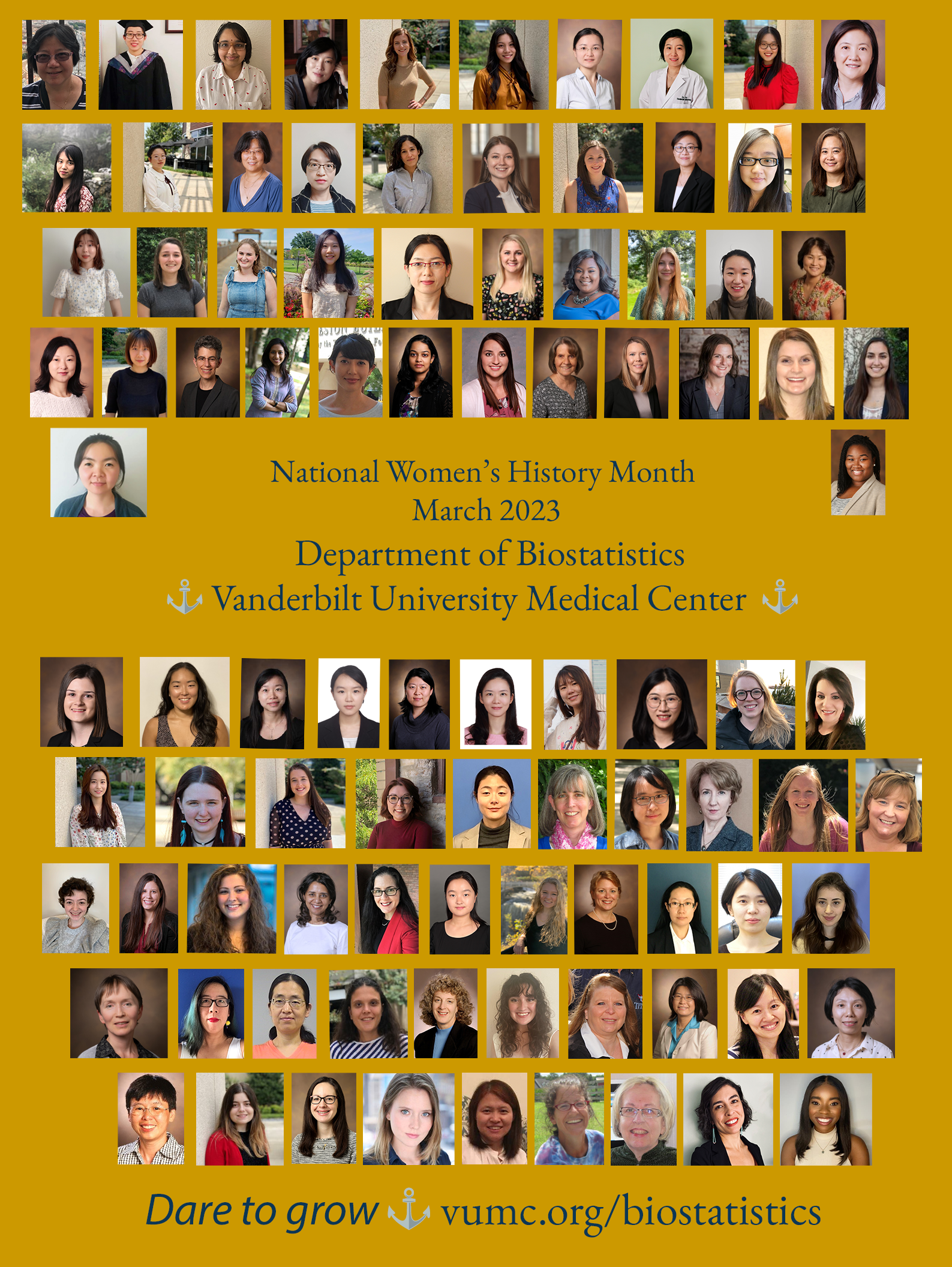
Visit the Our People section of this site to learn more about our department members.
TOP ROW: senior associate Yuwei Zhu, PhD student Siwei Zhang, quality assurance analyst Vinni Yenukonda, professor Fei Ye, PhD student Elisa Yazdani, MS student Lydia Yao, postdoc Jing Yang, PhD student Yan Yan, PhD student Bailu Lucy Yan, lead biostatistician Meng Xu
ROW 2: biostatistician Ke Xu, PhD student Jiangmei Ruby Xiong, research professor Pingsheng Wu, application developer Hui Wu, PhD student Julia Whitman, PhD student Valerie Welty, PhD student Hannah Weeks, lead biostatistician Li Wang, research assistant professor Jing Wang, chief business officer Janey Wang
ROW 3: PhD student Shengxin Tu, PhD student Julia Thome, health services research analyst Afan Swan, PhD student Tianyi Sun, senior biostatistician Lili Sun, associate program manager Kayla Sullivan, program manager Cierra Streeter, biostatistician Tess Stopczynski, biostatistician Ine Sohn, adjunct instructor Ayumi Shintani
ROW 4: lead biostatistician Yaping Shi, PhD student Lan Shi, research assistant professor Laurie Samuels, biostatistician Paridhi Ranadive, statistical genetic analyst III Marisol Ramirez-Solano, associate professor Rameela Raman, senior biostatistician Heather Prigmore, associate Sharon Phillips, lead biostatistician Amy Perkins, research associate professor Jackie Pennings, biostatistician Rebecca Owens, application developer Savannah Obregon
ROW 5: assistant in biostatistics Hui Nian, educational programs manager Chazlie Miller
ROW 6: senior biostatistician Elizabeth McNeer, associate biostatistician Cara Lwin, associate professor Qi Liu, assistant professor Jinyuan Liu, associate professor Dandan Liu, adjoint assistant professor Pei-Ying Emily Lin, biostatistician Yajing Li, postdoc Jia Li, PhD student Lisa Levoir, senior program manager Jess Lai
ROW 7: MS student Yeji Ko, PhD student Jamie Joseph, MS student Megan Taylor Jones, biostatistician Cassie Johnson, biostatistician Xiangyu Ji, lead biostatistician Cathy Jenkins, research assistant professor Li-Ching Huang, senior financial analyst Sandra Hewston, biostatistician Cassie Hennessy, assistant in biostatistics Kim Hart
ROW 8: MS student Megan Hall, assistant professor Amber Hackstadt, business process manager Nicole Gunnison, senior associate Tebeb Gebretsadik, VICTR associate director Cheryl L. Gatto, biostatistician Yue Gao, PhD student Alexis Fleming, research professor Irene Feurer, senior biostatistician Xiaoke Sarah Feng, principal biostatistician Run Fan, health services research analyst Andrea Elhajj
ROW 9: research assistant professor Svetlana Eden, senior program manager Peg Duthie, research assistant professor Liping Du, PhD student Chiara Di Gravio, professor Mary Dietrich, associate program manager Margaret Cullum, grants manager Pattie Council, vice chair of diversity and inclusion Leena Choi, research assistant professor Sheau-Chiann Chen, vice chair of education Qingxia Cindy Chen
ROW 10: research associate professor Heidi Chen, PhD student Marisa Blackman, biostatistician Caroline Birdrow, project manager Heather Bickham, principal biostatistician Aihua Bian, vice chair of informatics and collaborative programs Lynne Berry, adjunct instructor Mary Banach, assistant to the chair Jena Altstatt, health services research analyst Onika Abrams